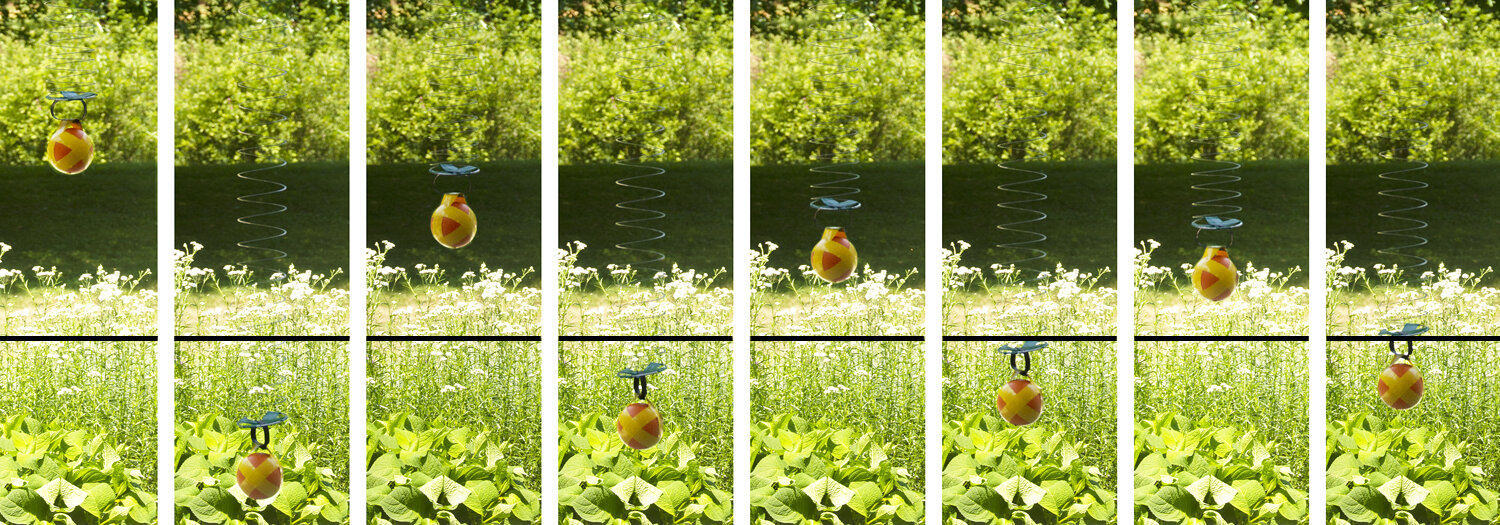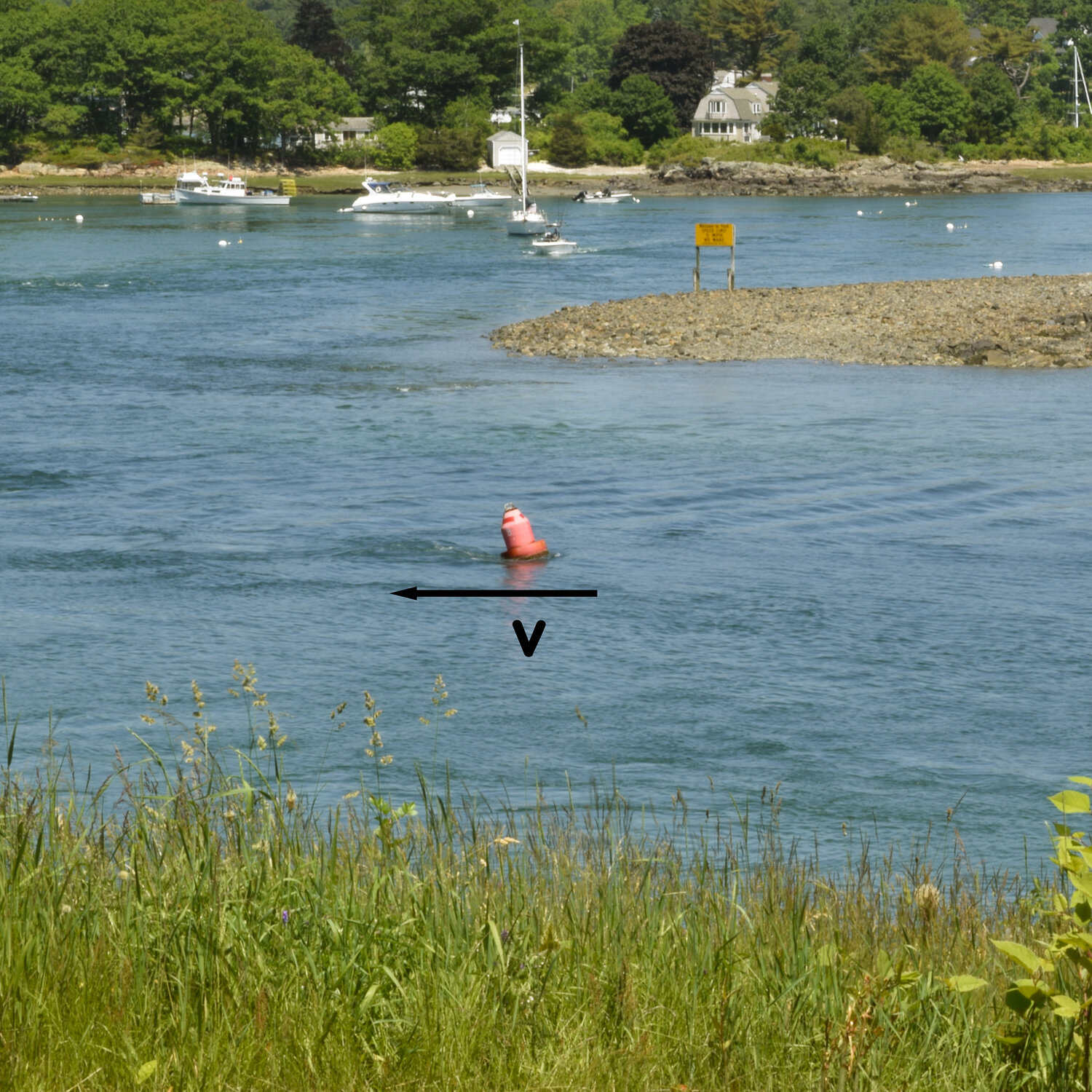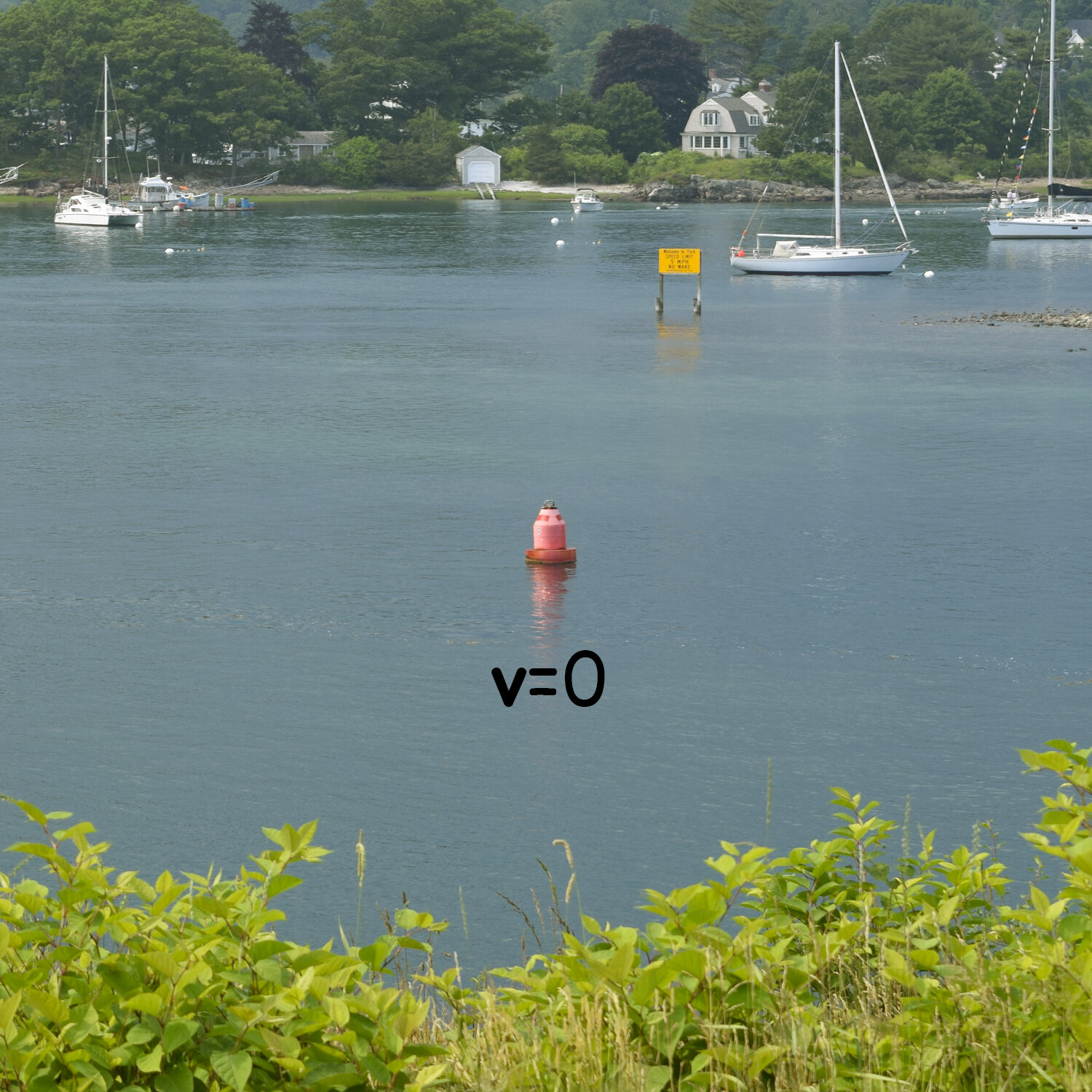Other Oscillators
A weight bouncing up and down (or back and forth) at the end of a spring is an example of simple harmonic motion. A swing or pendulum oscillating with a small amplitude is another example. In both cases, the total amount of mechanical energy, kinetic plus potential, stays the same, even though the proportions change. During one complete period of motion, the energy changes from all potential to all kinetic to all potential and so on, with a mix of kinetic and potential in between. There are many other examples of oscillators where the same kind of energy transfer happens. Some oscillators may not obey simple harmonic motion but their motion falls into the larger category of periodic motion, motion that repeats over and over. For this group of oscillators we can identify an amplitude of motion, a period or frequency of oscillation, and we can observe the same energy transfer from kinetic to potential. In this section, we will take a look at some familiar examples.
The Pogo Stick
A pogo stick is a fun toy that allows you to jump up and down. The rigid frame has foot pegs for your feet to stand on and handles for you to hold onto. The distance between the foot pegs and handles stays the same but a solid metal shaft (or piston) at the bottom of the pogo stick moves up and down inside the frame when you bounce on it. A spring is inside. One end is connected to the frame and the other end is connected to the shaft.
A pogo stick has a spring inside that makes it possible for you to bounce up and down.
When you stand on the foot pegs, by balancing or holding onto a friend so you don’t tip over, the spring compresses a small amount so that it can support your body weight. In this equilibrium position, the restoring force of the compressed spring (pointing up) is equal and opposite your weight (pointing down).
In the equilibrium position, the upward restoring force of the spring balances the downward force that is your weight.
If the spring is weak, the pogo stick can only be used by small kids who don’t weigh too much. For larger kids and adults, the spring needs to be much stiffer.
Now suppose you start jumping up and down on the pogo stick. When you jump down onto the foot pegs, as shown in frame 1 of the image below, the spring compresses more than when it is in the equilibrium position. With more compression of the spring, the restoring force becomes larger than at equilibrium. This large force, pointing up, is greater than your weight, pointing down. The net force, pointing up, causes you to accelerate upward. You travel upward (frame 2) and stop at the top (frame 3) where the spring is no longer compressed. The only force acting on you at this point is your weight (the force due to gravity) and it causes you to head back down as the spring starts to compress once again (frame 4) until it is fully compressed at the bottom (frame 5).
The net force points upward when the spring is compressed, causing you to accelerate up off the ground.
As with all of the oscillators we have discussed so far, we can use energy instead of forces to describe bouncing on a pogo stick. First, we can assume that the potential energy of you on the pogo stick is zero at equilibrium, where all the upward and downward forces cancel each other. Next, when you jump down on the pogo stick (frame 1 below), you do work to compress the spring, giving it some potential energy: spring potential energy.
A spring inside a pogo stick allows you to bounce up and down. Your potential energy is due to the compressed spring at the lowest point and to your height above the equilibrium position at the highest point. During an oscillation, the energy is in the form of kinetic energy, spring potential energy and gravitational potential energy.
As you move up (frame 2), the potential energy starts to change into kinetic energy. Pretty soon the pogo stick lifts off the ground and comes to a stop at the top (frame 3). Here, the kinetic energy is zero (because you are no longer moving). You have only potential energy, but it is gravitational potential energy. The spring has nothing to do with it! As you begin to drop back down toward the ground, you pick up speed once again (frame 4). Your energy is mostly in the form of kinetic energy and as soon as the pogo stick hits the ground, the spring starts to compress. At the bottom (frame 5), your energy is once again in the form of potential energy but it is due to the compression of the spring. To summarize, the pogo stick has a transfer of kinetic and potential energies during a cycle but the potential energy is in two forms: spring potential energy (at the bottom) and gravitational potential energy (at the top).
The Trampoline
A trampoline is a taut piece of cloth that is attached to a circular frame with a lot of springs around the edge. It is a lot like a pogo stick. When you jump up and down on a trampoline, your energy changes from one form of potential energy to another, with kinetic energy coming and going in between.
To begin bouncing on a trampoline, you need to jump down on it as shown in frame 1 of the image below.
After you bounce down on a trampoline, a transfer of energy helps you jump into the air.
This downward force does work on the springs, causing them to stretch and giving them some potential energy: spring potential energy. Because springs don’t like to be stretched (or compressed) too much, that potential energy starts to get converted to kinetic energy as the springs return to their unstretched length, causing you to start moving up. For a while, there is kinetic plus spring potential energy in varying amounts (frame 2). Soon, you lift off the trampoline (frame 3). You are still moving so you still have kinetic energy, but you are suspended over the trampoline, which means you have some potential energy, too - gravitational potential energy. When you get to the maximum height above the trampoline (frame 4), you momentarily stop so you no longer have any kinetic energy. Instead, the energy is all gravitational potential energy, just like it is when you are at the highest point above the pogo stick. The trampoline is not stretched when you are above it, just as the spring is not compressed when the pogo stick is off the ground. The energy is completely in the form of gravitational potential energy at this point.
Gravitational potential energy gets converted to kinetic energy and spring potential when you fall back down onto the trampoline surface.
Once you start to drop down (frame 5), some of your gravitational potential energy is converted to kinetic energy. After you land (frame 6), the springs around the trampoline once again start to stretch and some of the kinetic energy gets converted to spring potential energy. At the bottom (frame 7), the springs are stretched the most, you come to a stop, and all of the energy is in the form of spring potential energy. To summarize, the trampoline is like the pogo stick. There is a transfer of kinetic and potential energies during a cycle but the potential energy is due to both the stretching of the springs around the edge and your height above the equilibrium position. The difference is that on a pogo stick, the spring potential energy is due to the compression of the springs while on a trampoline, the spring potential energy is due to the stretching of the springs.
The Pump Track
If you have ever ridden on a mountain bike, you may know about pump tracks. A pump track is a path through a field that has lots of small ups and downs. When you ride your bike on one, the idea is to keep going without pedaling. Once you get going, you have some kinetic energy. Some of that energy gets converted to potential energy as you go up the hills and slow down. That potential energy gets converted back to kinetic energy when you go down the hills on the other side and speed up. This change in speed - going slower at the top of the hills and faster at the bottom of the hills - happens because of a transfer of energy from kinetic to potential and it doesn’t require any pedaling!
Energy changes from kinetic to potential when you ride on a pump track.
For a trampoline or pogo stick, there are points in the cycle when there is no motion, so the energy is all in the form of either spring or gravitational potential energy. For pump tracks, the idea is to keep moving so the kinetic energy never quite becomes zero. Instead, only some of it gets converted to potential energy when you go up the hills.
Damped and Forced Harmonic Oscillators
Suppose there is a ball hanging on a spring. When you pull down on the ball and let go, it will start oscillating, as we have seen in several examples so far. If you go away and come back later, you may see that the ball is still oscillating. If it is, you will also see that the amplitude is much smaller than it was when you first let go. If we lived in a perfect world, the oscillation would continue with the same amplitude forever. But our world is not perfect. There is air resistance, which acts to slow down the ball as it moves. The spring is not perfect either. All along its length it has mass of its own, even though the spring’s mass is much less that that of the ball hanging off the bottom. Imperfections such as these cause the bouncing motion to change a little bit with each cycle. The most noticeable change is in the amplitude. This constant reduction in amplitude is called damping and the motion is called damped harmonic motion.
For damped harmonic motion, the amplitude decreases gradually over time. The equilibrium position is marked by the black line.
Damped motion occurs when you are swinging on a swing. You will see it if you bounce a ball onto a hard floor, and watch the height it reaches with each bounce. What can be done to keep the amplitude of an oscillation from reducing? All it takes is a force, applied periodically to the person on a swing or ball bouncing on the floor. When a force is applied in this manner, the motion is called forced harmonic motion. And if you apply a large enough force at just the right time each cycle, something called resonance might occur. When an oscillator achieves resonance, the amplitude of the oscillation will grow. If the force is not applied consistently each cycle, the oscillation will quickly fade away. To keep an oscillator going with a steady amplitude, a periodic force is required that has a matching frequency and just the right amount of strength.
The Hammock
On a swinging hammock, for example, your amplitude will decrease pretty quickly if someone gives you an initial push and then walks away. But if you get a push each time, you can keep going with a pretty big amplitude. This happens when you are on a swing, too, if someone pushes you every time you return to the same side of the swing.
The suspension springs on cars are designed to keep the car from resonating when it goes over bumps in the road. There are times, though, when you get more bounce than you want! It all depends on your car, your speed, and the spacing of the bumps on the road.
Flying Birds
When birds fly, their wings flap up and down in a repeating motion. The wings come to a stop at the top and bottom of their motion and move fastest in the middle. The muscles in a bird’s chest are used to keep this flapping motion going, so is another example of forced harmonic motion. The flapping motion has a period (or frequency) and an amplitude, both of which depend on the size of the bird. Just as the period of a pendulum depends on its length, the period of flapping wings depends on the length of the wings. This is why small birds flap their wings with a higher frequency (or a shorter period) and large birds flap their wings with a lower frequency (or a longer period).
Birds’ wings are forced harmonic oscillators.
Clocks
We have learned that a pendulum swings back and forth with a steady period (or frequency) that depends only on the length of the pendulum. This property of pendulums was used early on when clocks were first invented. The clock pendulum is a great example of a forced harmonic oscillator. When you wind a pendulum clock, you put potential energy into the clock mechanism, which is often a spring in the form of a spiral. When you add potential energy to to this kind of spring, the spiral gets tighter. A gear, like the sprocket on a bike, allows the spring to uncoil only a small amount with each swing of the pendulum. This delivers a small force to the pendulum with each swing, keeping the motion going without damping.
Pendulum clocks come in all sizes: tall, medium and small. Because the period of a pendulum depends only on its length, this tells us that the periods of the swinging motion inside pendulum clocks are all different. But the gears are set up so that the minute and hour hands rotate at the correct speed no matter how big or small the clock pendulum is.
Pendulum clocks come in different sizes but all are examples of forced harmonic oscillators.
Tides
If you have ever visited the seashore, you may have noticed that the water level changes as the water moves in from the ocean and back out again. As the tide changes, you can see more or less sand on the beach leading up to the water’s edge. You might also see strong currents one way or another in nearby rivers as they empty into the ocean and fill back up again. The back and forth motion of tidal water, resulting from the periodic motion of the moon around the earth, is another example of an oscillator.
At low tide in a river (upper left), the velocity of the water is zero. You can tell that the water isn’t moving because the buoy is pointing straight up. As the tide comes in (upper right), the velocity of the water increases and the buoy gets tipped to one side. The water moves fastest at mid-tide, a time that is halfway between the times of high and low tide. At high tide (lower left), the velocity is once again zero and the buoy sits straight up. The velocity is greatest once again when the river is at mid-tide going out (lower right) where the buoy is not tipped in the opposite direction. The amplitude of this oscillator is the distance between the height of water at mid-tide and the height of water at either low or high tide. The period is about 12 hours and 25 minutes. While it doesn’t look like a pendulum or a weight bouncing on a spring, the periodic motion of the tides is very much an oscillator!
As you look around, what other kinds of oscillating motion can you see?

















